Celebrating National Fast Food Day with a tour featuring Dairy Queen, Burger King, Pizza Hut, A&W, McDonald's, Kewpee Burgers, Arby's and Dunkin' Donuts
It's National Fast Food Day, and to mark the occasion, I've combed through two years of Instagram data -- sort of like rooting through a bag of McDonald's in search of that last, hidden fry -- and put together a list of some of my most popular photos of classic chain restaurants, the photos you really liked! (I like them, too!)
Click on the photos to open them up and explore the photo galleries!
1.) Dairy Queen, Butler, Pennsylvania
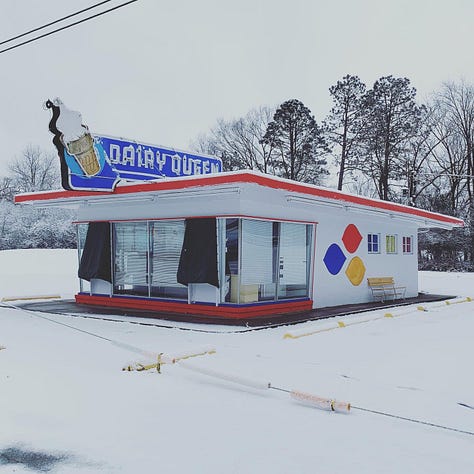
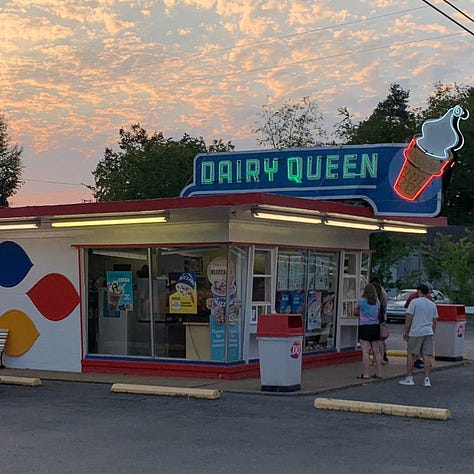


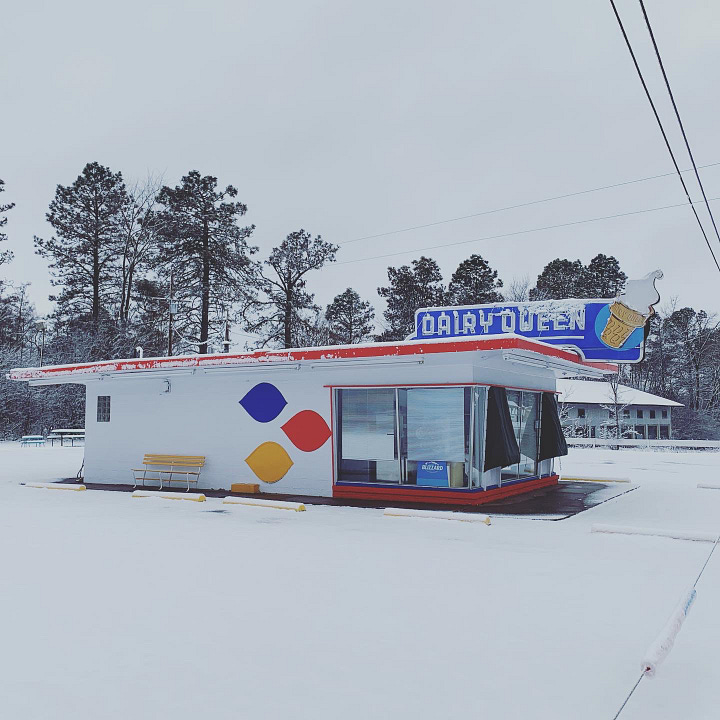
The gorgeous Dairy Queen was closed for the season when I visited on February 2, 2020, but I was still able to enjoy a “blizzard.” Well, I’m exaggerating. It was merely a coating of snow that fell Sunday morning in Butler, Pennsylvania, but it was enough to turn this scene into a midcentury take on Currier and Ives.
This 1950s DQ has a twin in the same town, which recently left the Dairy Queen chain after a dispute with corporate. That store is now called Edwards Ice Cream, named after family that’s owned the business for decades. I’m glad they were able to stay in business. [Map]
2.) Burger King, Myrtle Beach, South Carolina


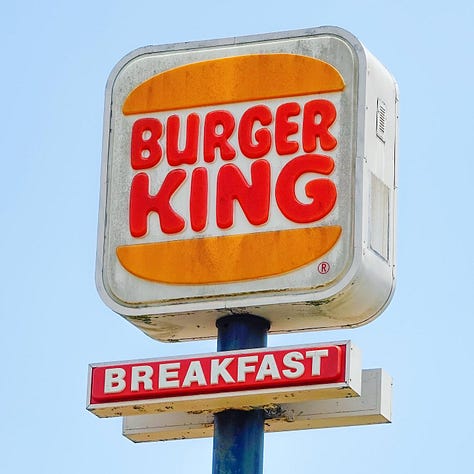
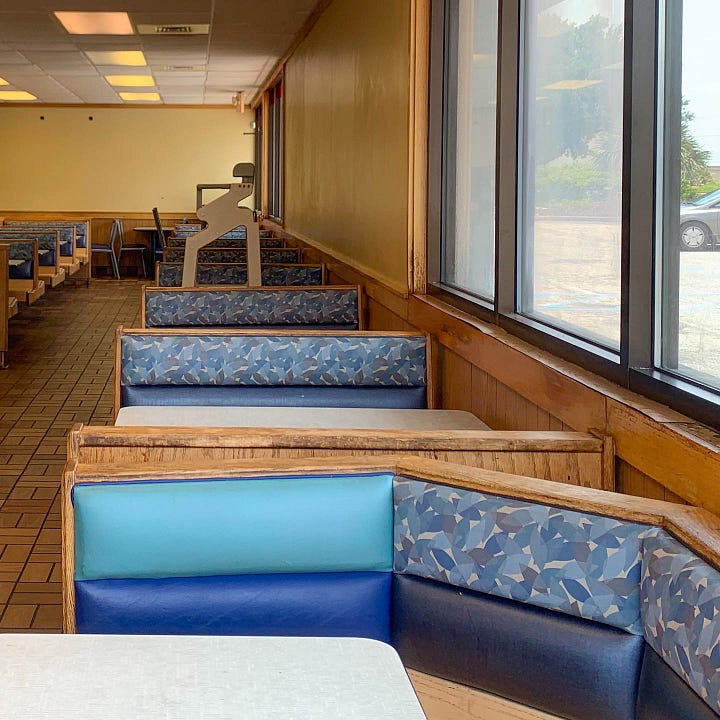
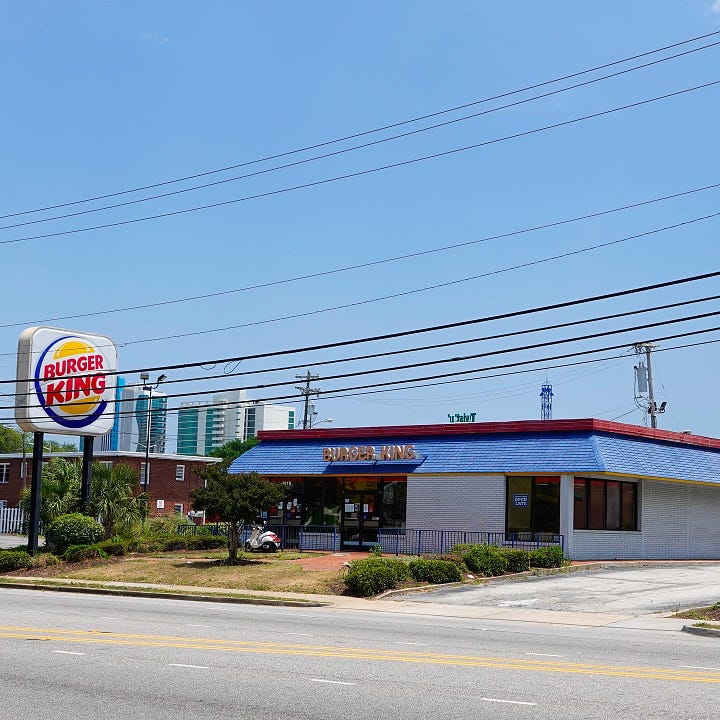
I finally had it my way! You’re looking at an important piece of American fast-food history. This is quite possibly the last Burger King sign still attached to a store that features the beloved 1969 logo.
In 2020, Burger King, quietly at first, began to roll out a revival of this logo in select stores. You read about it here first, four months before it became official. This new retro logo is not exactly the same as the 1969 logo, but it is very much in the spirit of the original.
But this, my friend, the sign you see here, is the original, a “Whopper” of a survivor. And this sign, by the way, is easy to miss. It’s on a pole in the back parking lot of the restaurant.
The bigger sign out front also featured this classic logo until 2017 or so, when it likely became the last of Burger King’s over 17,000 stores to be switched over to what I call the 1999 “Swoosh” logo. In January 2021, Burger King announced the swoosh was dead, long live the square burger!
Had only a few more years passed, the main sign of this Myrtle Beach store may well have been left alone. But fortunately, this smaller sign remains out back, almost forgotten, yet a significant piece of fast food history.
The survival of this sign reminds me somewhat of the “sleeping sombrero” Taco Bell sign that lingers behind a store in Savannah, Georgia, also the last of its kind in the wild. Location is everything, they say, and oftentimes the only thing keeping something special like this alive.
I snapped some photos here at 501 S. King’s Highway and I was on my way. It was hard to leave Myrtle Beach on a hot summery day, just a few blocks from the beach. But there was a lot of Americana waiting to be discovered, and time was a wastin’.
Since I visited, the restaurant has been renovated, but the vintage sign survives in the back. [Map]
3.) Pizza Hut Classic, Spring Lake Park, Minnesota
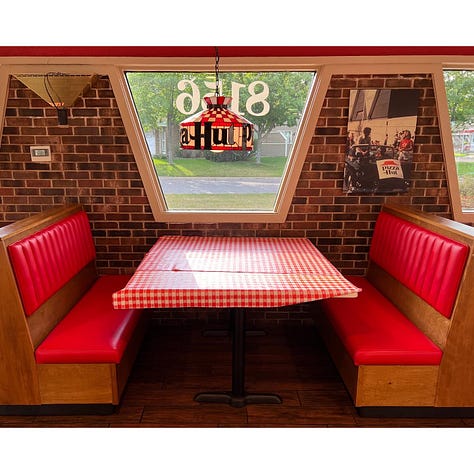
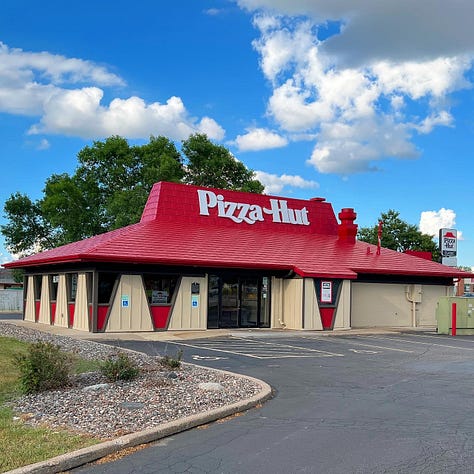
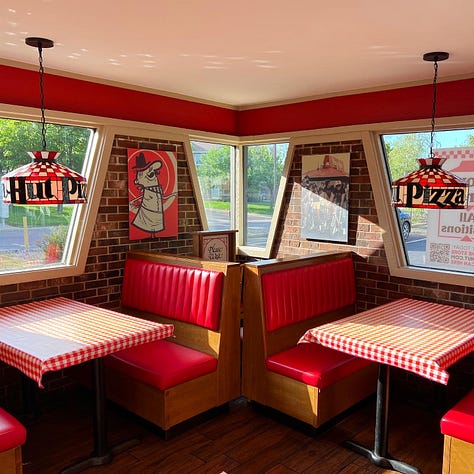
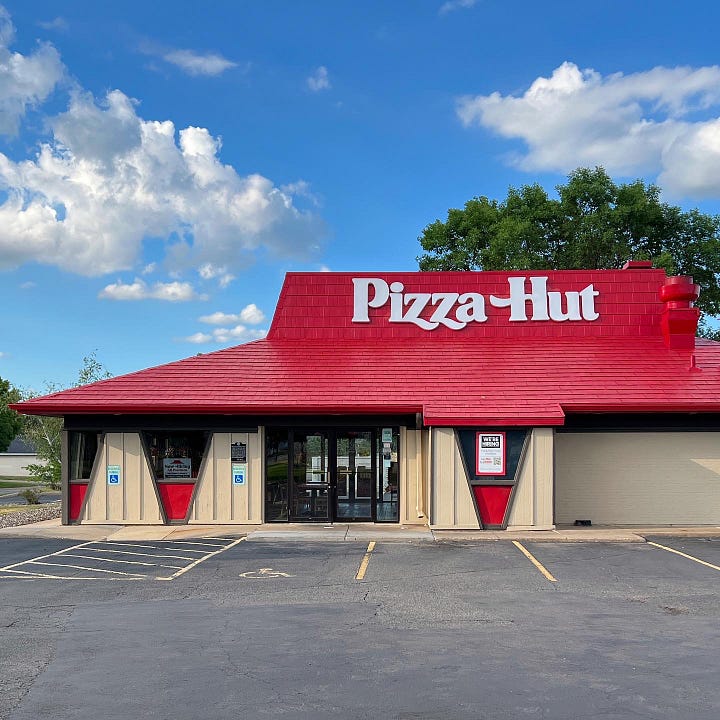
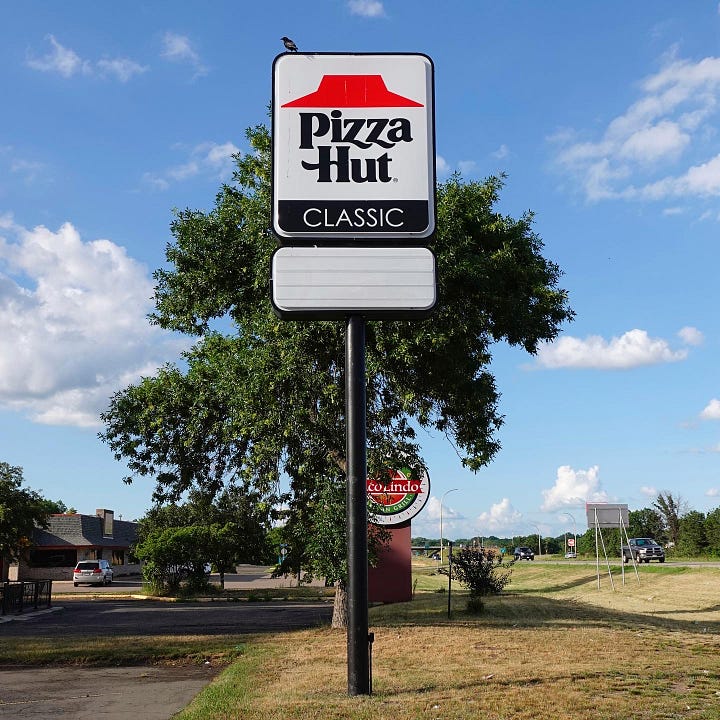

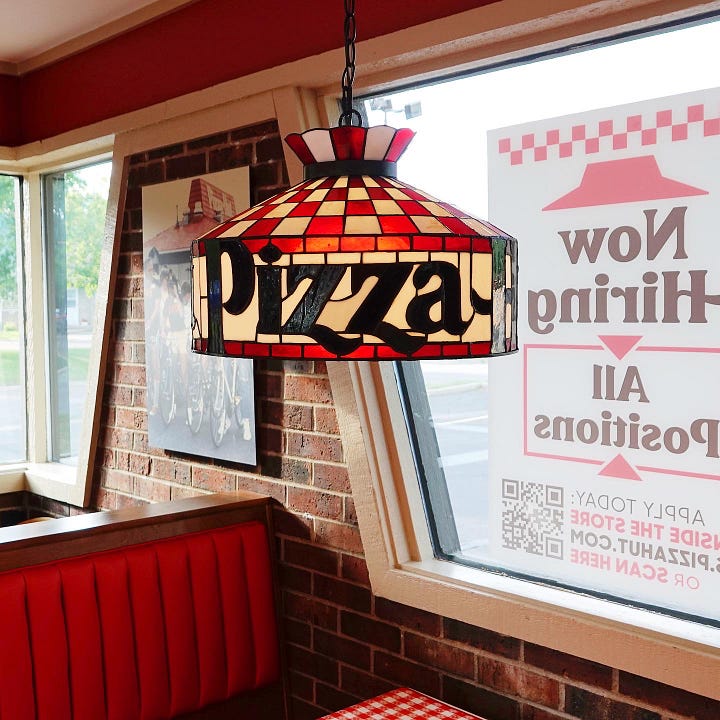
I discovered this “Classic” location back in July through a serendipitous suggestion from a reader, who messaged me about this store just as I was about to leave Minneapolis and head north after a few days exploring the Twin Cities.
It just so happens that Spring Lake Park was right on my way, and only 20 minutes from the hotel from which I was departing.
I arrived right before dinner time, and had the dining room all to myself, though the carry-out and delivery business appeared brisk.
The manager told me this Pizza Hut opened in June or July of 1972, which means it’s celebrating its 50th anniversary, which is an impressive run. (I failed to bring something gold to mark the occasion!) Now that it’s been converted into a Classic, it looks today more like it did in the 1970s than at any time since, let’s say, the 1990s.
Pizza Hut Classics are part of the chain’s nostalgia-based marketing efforts that began with the return of the 1974 logo in 2019. That logo had been discarded — along with much of the charm of the old restaurants — in 1999.
There were two more Pizza Hut Classics awaiting me on this trip. The next morning, I found one in Bemidji, Minnesota, where I’d gone in search of Paul Bunyan and his ox, Babe. I found another Classic that evening in Black River Falls, Wisconsin. [Map]
RELATED: MY EXCLUSIVE FULL LIST OF PIZZA HUT CLASSICS IS HERE!
4.) Pizza Hut Classic, Bryson City, North Carolina

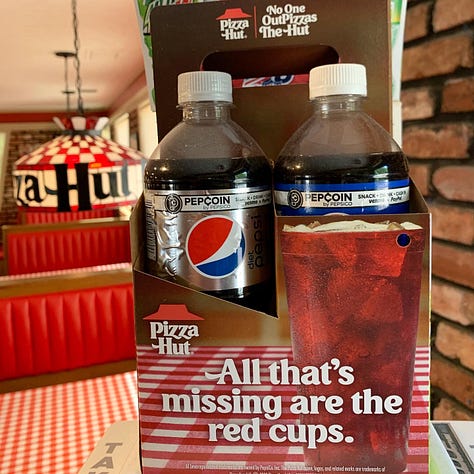

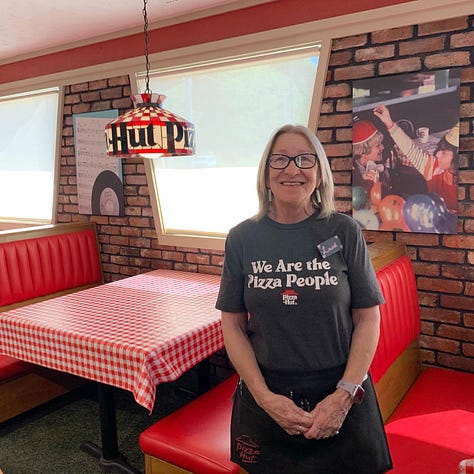


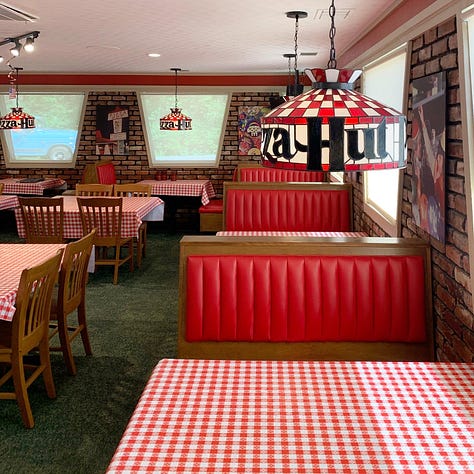

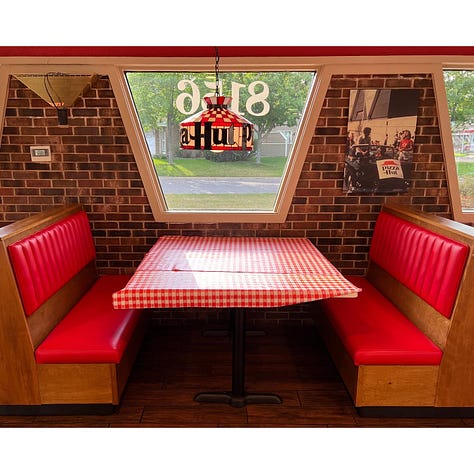
Bryson City, North Carolina is a small mountain town that bills itself as the Gateway to the Great Smoky Mountains. It’s a beautiful town for the lover of the great outdoors, for the lover of history, and, as you can see from these pictures, for the lover of personal pan pizzas served in a setting that’s straight out of 1978.
Indeed, that’s the year this town’s Hometown Pizza Hut, as the old slogan went, opened. But it wasn’t always this time capsule. Back in 2019, Pizza Hut returned to its classic hut logo from 1974, discarding the jaunty 1999 replacement from the era where chain restaurants felt compelled to update their logos.
It must have been Y2K madness, because why would you discard that logo? Well, the mistake was corrected 20 years later, and soon, Pizza Hut was “retro renovating” legacy shop to look like what Pizza Huts should look like.
General manager Laurel McMahan told me that this location was among the lucky ones chosen to get the old-school makeover.
At Bryson City, inside and out, the restaurant looks just like the Pizza Huts of my youth. Laurel has worked here for seven years, and has been the general manager for two, and her pride in running this location is evident, right down to her T-shirt.
I visit hundreds of restaurants a year, often asking nosy questions for my essay, and it’s rare for somebody to be this nice and hospitable. It’s a reminder that chain restaurants are at their core local restaurants, too, run by your neighbors.
For a slice of Southern hospitality, retro charm and pizza, the Pizza Hut in Bryson City should be on your itinerary for your roadside Americana road trips. Oh, and the mountains are nice, too. [Map]
5.) A&W, Wilmington, New York
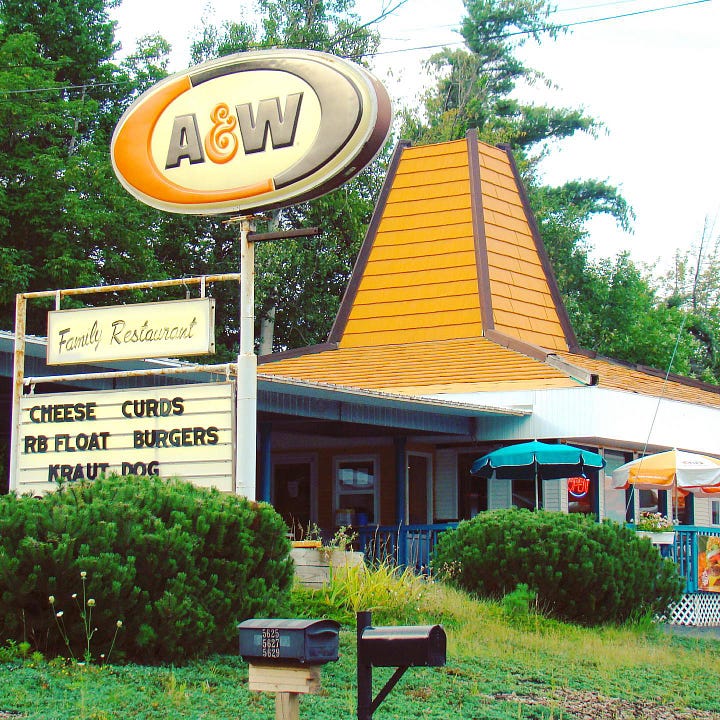
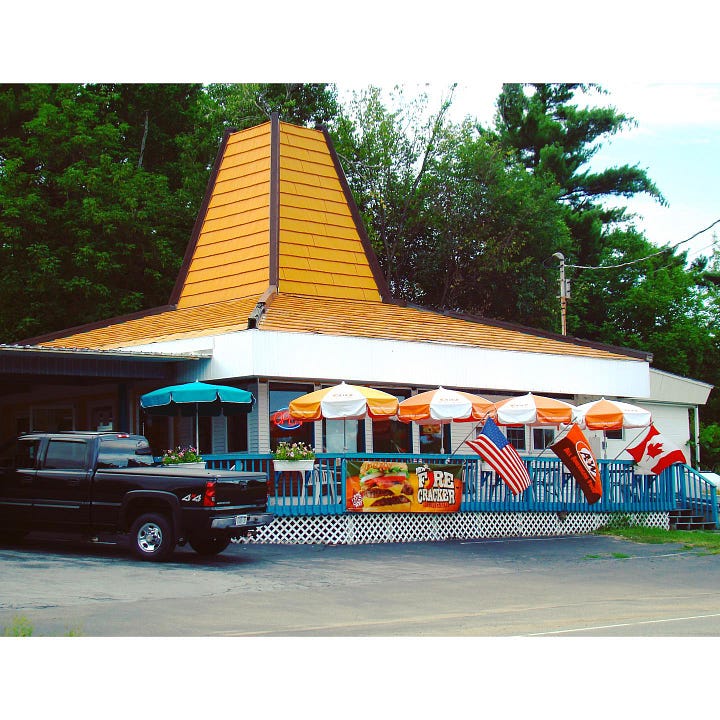


On June 20, 1919, a humble root beer stand opened on a hot day in Lodi, California. Roy Allen’s frosty beverage, sold for a nickel a mug, would become the foundation of the A&W root beer chain of restaurants. In August 2008, in the Adirondack Mountain town of Wilmington, New York, I happened upon a vintage 1966 A&W restaurant, a charming roadside relic if there ever was one.
I stopped here on a chilly late August day; it can get pretty cold up this way in the late summer — the town appropriately features a hamlet named North Pole. It’s a happy memory.
I still keep the glass A&W mug I bought that day in the freezer, nice and frosty, ready to make a serving of root beer (or a more potent potable) extra special. [Map]
6.) McDonald's, Tomah, Wisconsin and Cresson, Pennsylvania
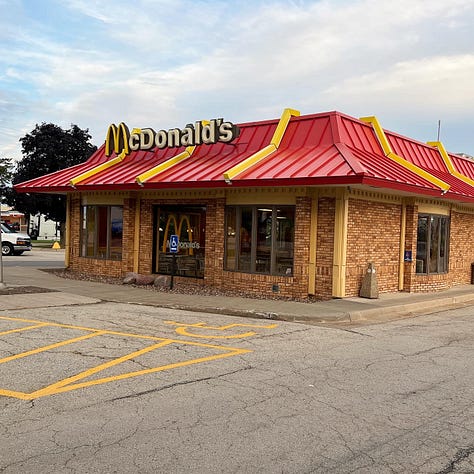

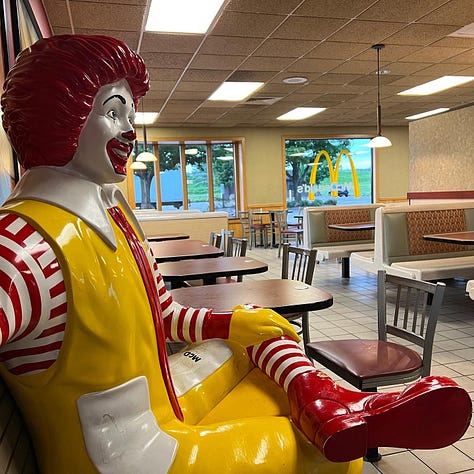

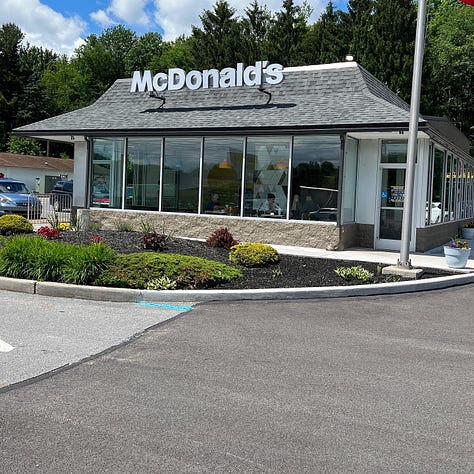
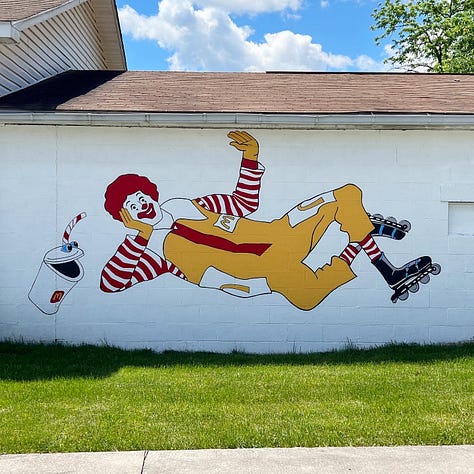
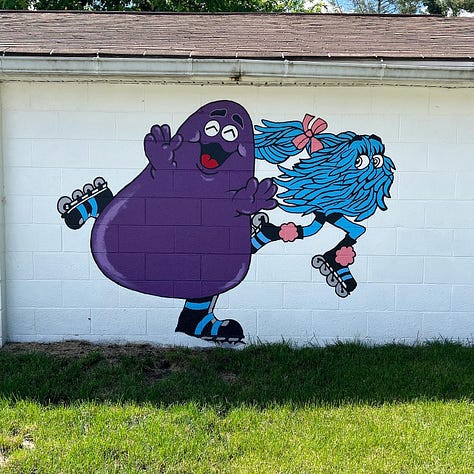


In just a few years, McDonald’s restaurants like the one you see here went from practically everywhere to just about nowhere – not an easy thing to accomplish when you have over 13,000 of them in the United States alone.
Sure enough, in the almost 5,000 miles I logged on roads from New England to Minnesota this past summer, I only spotted under a dozen mansard-roofed McDonald’s.
When I hit the interstates, I always look for the towering Golden Arches sign, not to find a snack but to see if the mansard roof is still there.
First introduced in 1968 to blend into suburban settings where the earlier “red and white” stores with Golden Arches were not welcome, the mansard design spread quickly, only beginning its long goodbye a generation later.
In 2003, the Chicago Tribune reported that McDonald’s execs feared customers were tired of the mansards. The company began examining alternatives and was soon lovin’ the McBox.
But the old mansards are not entirely gone, and today, I’ll present two interesting locations from my recent trips.
This summer, I spotted this mansard McDonald's while driving down Interstate 94 in Tomah, Wisconsin. It’s a textbook example, with the red roof, the yellow brackets, the brown brick, and the ”M” in the front window. A Ronald McDonald statue holds court in the dining room.
The rest of my photos are from a visit in early June to the McDonald’s in Cresson, Pennsylvania, where I was in for a McSurprise.
Until recently, this McDonald's had a red roof and yellow brackets. It has been renovated with the preferred muted grey tones, but the mansard was preserved! Yep, this is still recognizably a McDonald’s, and it's the second time I’ve spotted a mansard-friendly renovation recently.
But I’m saving the best for last here. The Cresson McDonald’s has preserved its murals featuring some of our favorite McDonaldland characters.
There’s Ronald McDonald, the Hamburglar, the Fry Guys and Grimace, all on roller skates. Birdie has no use for them, of course.
Officer Big Mac, Mayor McCheese and Captain Crook did not join the skating party, but we can't have it all, can we? [Map] [Map]
7.) Kewpee Burgers, Lima, Ohio
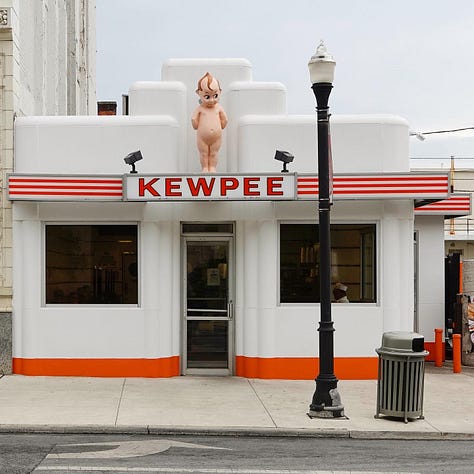

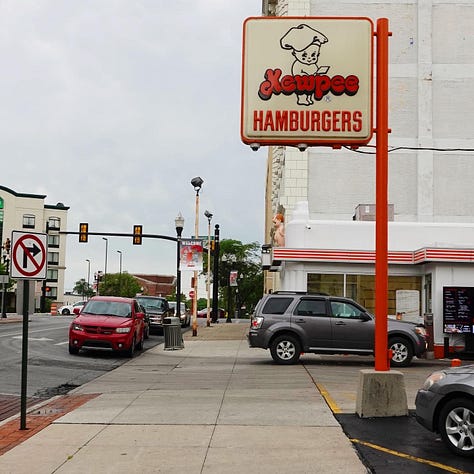
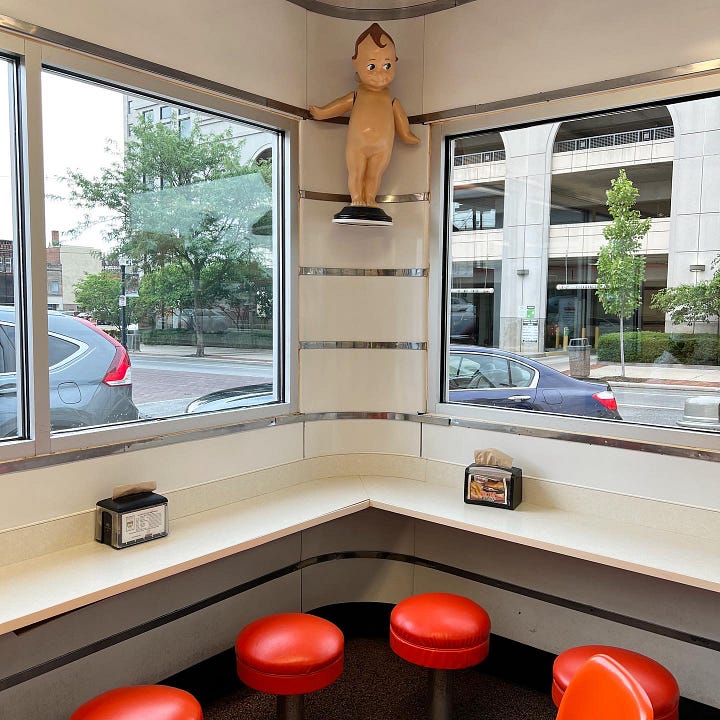
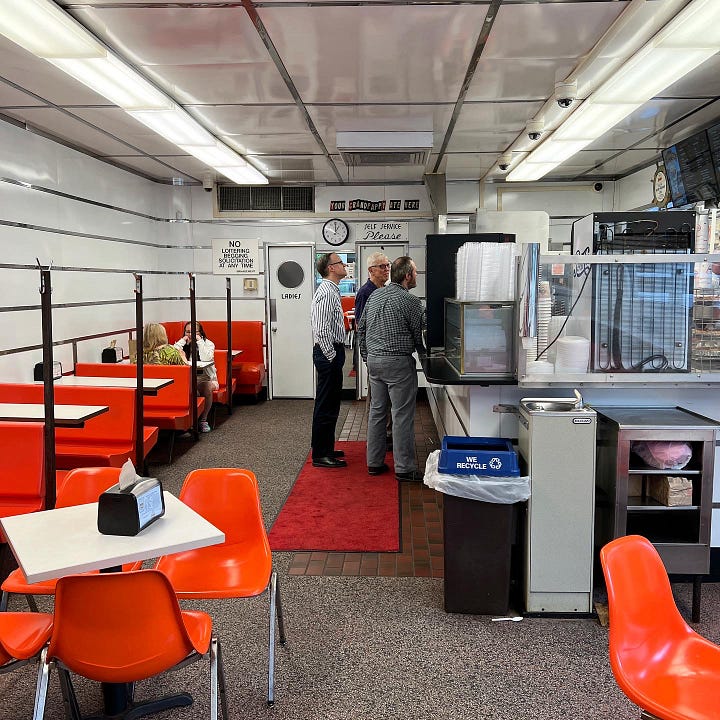
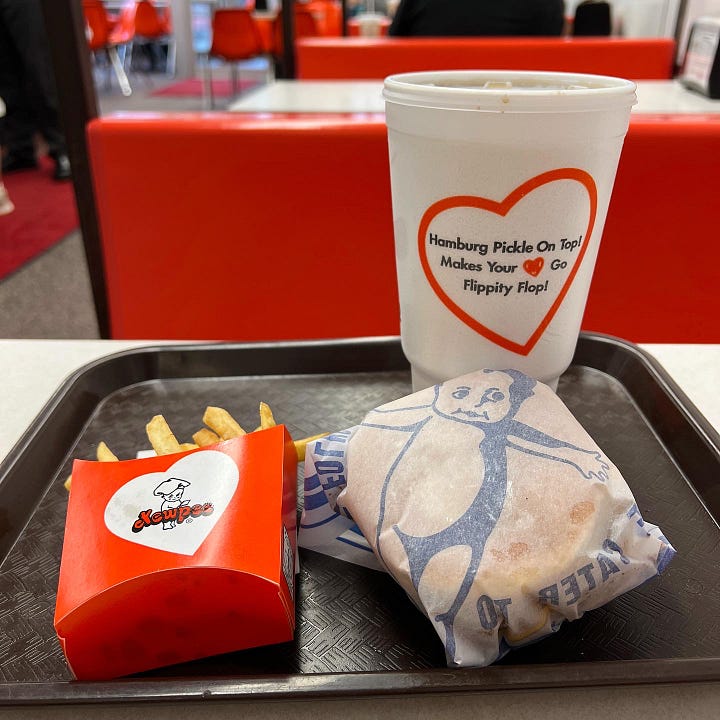

Hamburg Pickle On Top! Makes Your Heart Go Flippity Flop!"
That classic slogan for Kewpee Hamburgers applies not only to the food but to the charming architecture at The Kewpee here in Lima, Ohio.
Back in July, I made my second visit to this roadside treasure, and unlike my first in 2019, the restaurant was open and hopping at lunchtime. I found a corner booth and snapped pictures between taking bites of their iconic square burgers, theorized to be an inspiration for Wendy’s founder Dave Thomas.
The very first Kewpee hamburger joint opened in Flint, Michigan, in 1923, called the Kewpee Hotel, making it one of the earliest fast-food chains, and the second oldest hamburger chain after White Castle.
In 1928, husband-and-wife team Hoyt and Julia Wilson opened the Lima store, and their shop was so popular that in 1939, they constructed this stunning Art Moderne building clad in porcelain enamel here on 11 N. Elizabeth St.
Kewpees once totaled over 400, but today, there are five locations left – one in Lansing, Michigan, another in Racine, Wisconsin, and three here in Lima (pronounced Lie-Ma). The ones in Lima, separate from the first two, are run by the Shutt family. The two other Kewpee restaurants in Lima are yellow mansard-roofed buildings.
But the one you see here is the very picture of cuteness overload.
Greeting us is cherubic Kewpee, inspired by the Kewpie dolls (note the different spelling) that were all the rage in the early 20th century and are still cherished by collectors. Kewpee has two siblings inside watching over things.
Getting a clean shot of the facade was difficult, as the lunchtime drive-thru crowd meant an endless queue of cars on Elizabeth Street, but I stood there until I had my opening.
Once upon a time, they offered curbside and drive-in service here. There was even a turntable for cars to exit the lot, which provided kids of all ages with a thrilling end to a tasty meal.
These days, the turntable is gone, but very little else has changed, thank goodness.
There's an old expression, “to win a Kewpie doll," meaning to win a trinket at, say, the state fair. But there's nothing cheap or insignificant about this Kewpee. [Map]
8.) Arby's, Cudahy, Wisconsin
The full story is in a recent newsletter! Click below to read it!
9.) Dunkin' Donuts, Lake Park, Florida
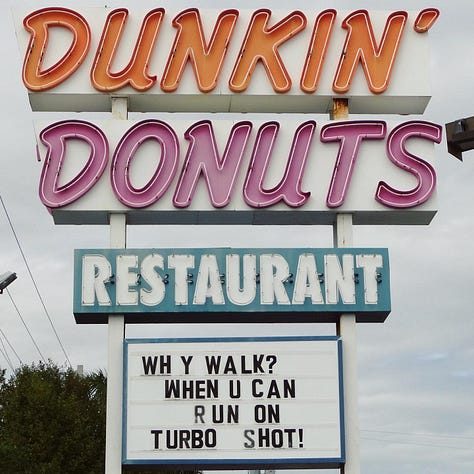
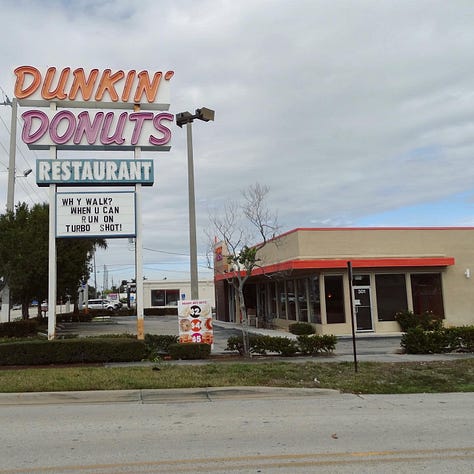
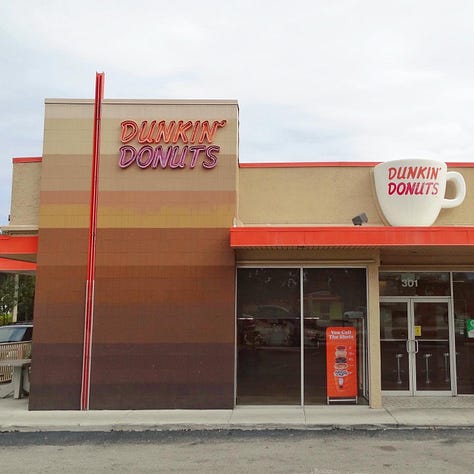
This was the first Dunkin’ Donuts to open in Florida, in 1962, and the chain’s last in the nation to serve as an actual, diner-style restaurant, with booths, plates, silverware, waitstaff, the whole bit!
Sadly, this location, in Lake Park, was turned into a traditional Dunkin’, much like all the other ones in America, in 2015. The restaurant was opened by William Rosenberg, the founder of the chain that was begun in Quincy, Mass. in 1948 as the Open Kettle. And then last year, the old neon sign, the last of its kind, was removed, reportedly sold to a collector.
In the 1960s, Dunkin was experimenting with diner-style restaurants, and opened a number of them, but the chain eventually settled on the tried-and-true formula of a small shop with donuts, baked goods and coffee. Even so, the Lake Park location stayed true to its diner roots until the owner decided in 2015 to embrace the national model. T
The Palm Beach Post reported the owner closed the diner side of the business in part because he couldn’t offer the menu items available at his other Dunkin’ locations — this restaurant lacked the equipment.
The old neon sign, the last of its kind still in service, was for a time preserved, as was the big coffee mug outside, a reminder of the days when waitstaff would serve you coffee from ceramic mugs. The interior also preserved tokens of the original, including a counter with swivel seats. [Map]
10.) Dairy Queen, Roseville, Minnesota
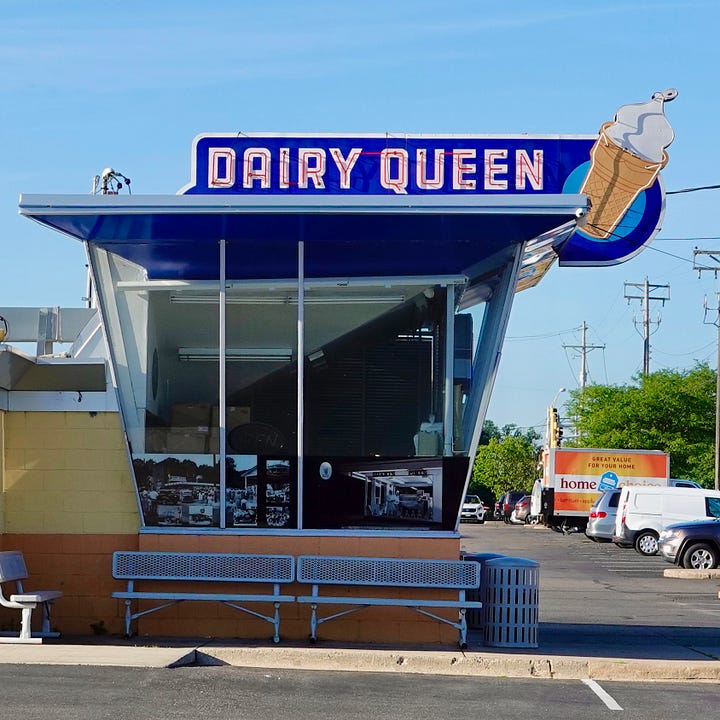

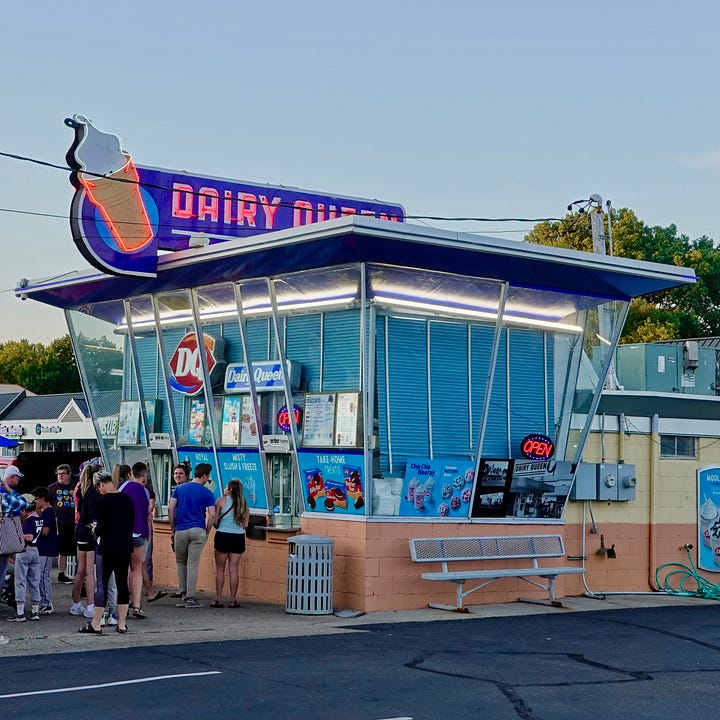
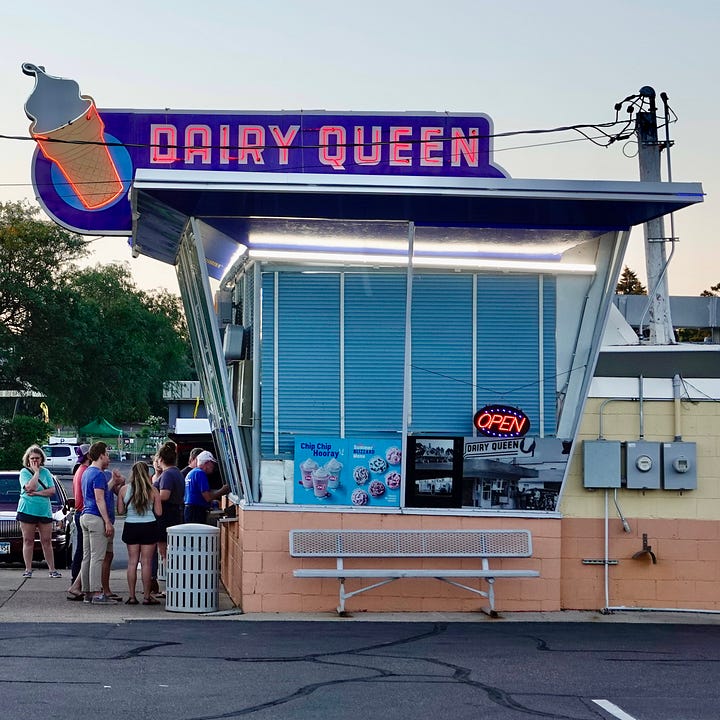
I spent most of my time off this summer in the Midwest, exploring the Land of Dairy Queen (though Texas has the most DQs).
A recent Dairy Queen roundup on Instagram brought thousands of comments, including many suggestions to visit this DQ is Roseville, Minnesota, a historic store that opened in 1947. I was so transfixed by this shop that I visited three times in August to get it in different light. To the eyes of this New York native, the slanted glass box reminds me of a Carvel on steroids! It truly is a jewel box. [Map]
A Personal Note: Please consider joining my newsletter and becoming a paid subscriber. Paid subscribers get full access to my archives, guides to places and classic brands, trip-planning advice and more! Reach out to me and let me know how I can help you enjoy roadside Americana! And you get the satisfaction of supporting my mission to document roadside Americana! It’s hard — and expensive — work! Thanks for your support!







